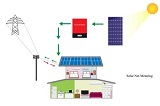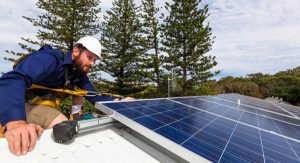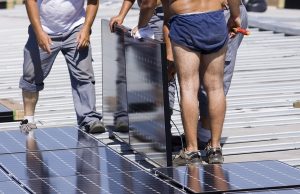Orbiting the Earth at an altitude of approximately 402 kilometers is a scientific and technological marvel symbolizing global cooperation and exploration – the International Space Station. The ISS is an incredible engineering feat and testament to human ingenuity for multiple reasons, including its innovative use of solar panels.

How Does the ISS Use Solar Panels?
The ISS uses large solar arrays to collect energy from the Sun and convert it into electricity to sustain its operations, support the crew, communicate with Earth and dodge flying space debris. This sophisticated solar power system transforms sunlight into electrical energy through the photovoltaic effect.
When sunlight hits the solar cells, they absorb energy from photons, causing the release of electrons. This process creates an electric current that flows through the cells. The more sunlight that hits the solar cells, the more electricity they produce.
To ensure optimal performance, the ISS’ solar panels rotate and tilt to always face the Sun, maximizing the amount of sunlight they receive. This tracking capability is essential, since the ISS orbits the Earth approximately every 90 minutes, experiencing sunrises and sunsets every 45 minutes.
Like many solar-powered homes on Earth, the ISS has a battery system to store any excess power its panels generate. These allow a continuous energy supply, even when the station is in Earth’s shadow.
The Value of the International Space Station
The ISS primarily functions as a microgravity laboratory, enabling scientific research in a unique environment that is impossible to replicate on Earth. Crew members conduct experiments in various fields, including biology, physics, astronomy and human physiology. These help us understand the effects of long-duration space travel on the human body and provide insights into fundamental scientific principles.
Additionally, the ISS has fostered scientific partnerships across borders, with researchers from different countries collaborating to further our understanding of space and improve life on Earth. The station also tests technologies and systems that will be crucial for future exploration missions beyond low-Earth orbit.
ISS Maintenance and Upgrades
The solar panels on the ISS are a reliable and sustainable power source in the harsh environment of space. They exemplify the importance of harnessing renewable energy sources for long-duration space missions and serve as a model for future space exploration endeavors.
As the ISS ages, its crew must contend with daily wear and tear, combined with additional changes like cosmic radiation and extremely cold temperatures. In 2022, astronauts made a series of three zero-gravity spacewalks to start upgrading the space station’s power system, adding six new roll-out solar arrays with a compact design that folds and unfolds like a blanket.
Despite being smaller than conventional solar arrays, ROSAs are highly efficient and can generate more than 30 kilowatts per panel. The additional power these arrays provide will ensure the ISS can continue operating to its maximum extent in the years to come.
A Bright Future in Space
The International Space Station represents a crowning achievement, embodying what humankind can accomplish when we work together toward a shared goal. As we continue to push the boundaries of human knowledge and exploration, the ISS will pave the way for future space missions, remaining an invaluable asset in our quest to unravel the mysteries of the universe.










